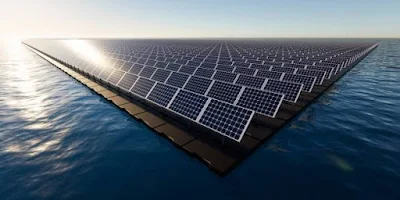Floating solar energy panels on water
INTRODUCTION
In modern times, the demand for renewable energy sources has increased rapidly, and solar power is one of the most popular options. However, large-scale solar plants require vast land, which is often unavailable or expensive in urban and industrial zones. To solve this challenge, Floating Solar Systems have emerged as an innovative solution. In this system, photovoltaic (PV) panels are installed on floating platforms over water bodies like reservoirs, lakes, or ponds. This setup helps in utilizing idle water surfaces while producing clean energy without occupying land.
WHAT IS A FLOATING SOLAR SYSTEM?
A floating solar system, also known as a Floating Photovoltaic (FPV) system, consists of solar panels mounted on a structure that floats on a water body. These systems are mainly used on still or slow-moving freshwater bodies. The solar modules are supported by high-density polyethylene (HDPE) floats that are UV-resistant and waterproof. These floating platforms are then anchored to the bottom or to the banks using mooring systems to prevent drifting.
COMPONENTS OF FLOATING SOLAR PLANTS
- Solar PV Modules – The photovoltaic panels capture sunlight and convert it into electricity. These are similar to land-based systems in design and function.
- Floating Structure – Made of polymer or HDPE pontoons that can carry the weight of panels and withstand water exposure.
- Anchoring and Mooring System – Provides stability to the floating system, preventing it from drifting due to wind or water movement.
- Inverter and Electrical Equipment – Converts the generated DC power into AC, suitable for grid supply or usage.
- Cables and Wiring – Special waterproof and corrosion-resistant cables are used to carry power from panels to the inverter and onward.
WORKING PRINCIPLE
When sunlight hits the solar panels, it generates electrical power via the photovoltaic effect. The energy flows through waterproof cables to the inverter placed on land or floating platform, which converts DC power to AC. This power can be used locally or fed into the grid.
Water bodies help in natural cooling of the panels, improving their efficiency compared to ground-based systems. The surrounding water reduces panel heating and also helps in minimizing water evaporation from the surface.
BENEFITS OF FLOATING SOLAR SYSTEMS
- No Land Requirement: Ideal for countries with land scarcity. Utilizes unused water surfaces.
- Increased Efficiency: Water cools the panels, increasing their power output by up to 10–15% compared to land systems.
- Reduces Water Evaporation: Covers the water surface and prevents direct sun exposure, saving water in reservoirs.
- Environmental Friendly: Doesn’t involve cutting trees or changing land use. Can coexist with aquatic life if designed well.
- Lower Dust Accumulation: Water surroundings reduce dust and dirt on the panels, requiring less frequent cleaning.
LIMITATIONS AND CHALLENGES
- High Initial Cost: Floating structures and anchoring systems are more expensive than land systems.
- Corrosion Risk: Continuous exposure to water and humidity increases risk of corrosion in metal parts.
- Installation Complexity: Specialized design, engineering, and anchoring are required depending on water body type.
- Limited Location Choices: Only suitable for still or slow-moving water bodies with stable water levels.
- Maintenance Access: Harder to reach and maintain equipment compared to land systems.
APPLICATION AREAS
- Water Reservoirs in Thermal Plants
- Irrigation Dams
- Hydropower Dams
- Industrial Water Treatment Ponds
- Drinking Water Reservoirs (non-intrusive designs)
CASE STUDY: INDIA’S PUSH FOR FLOATING SOLAR
India has started several large-scale floating solar projects to meet its renewable targets. Some notable examples:
- NTPC Kayamkulam (Kerala) – 100 MW FPV project over backwaters.
- Ramagundam (Telangana) – 100 MW floating solar plant on reservoir.
- Simhadri (Andhra Pradesh) – First 25 MW plant by NTPC on a raw water reservoir.
These plants are not only generating power but also saving lakhs of litres of water per year due to reduced evaporation.
FUTURE PROSPECTS
As land prices rise and water bodies remain underutilized, floating solar systems are expected to grow rapidly. With better designs, localized manufacturing of floating platforms, and government incentives, India and other countries can generate clean energy while conserving land and water. Technologies such as hybrid hydro-solar plants and floating solar + aquaculture models are also being explored to enhance economic returns.
CONCLUSION
Floating solar systems offer a smart, clean, and space-saving method of producing solar power. Though the initial investment is slightly higher, the long-term benefits in terms of efficiency, water conservation, and environmental safety make it a promising technology. For countries with vast inland water bodies and growing energy needs, floating solar can be a key solution for a sustainable energy future.




Post a Comment